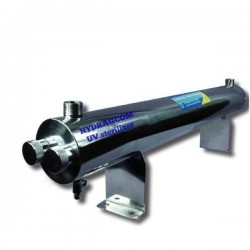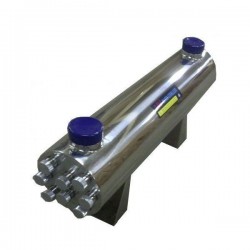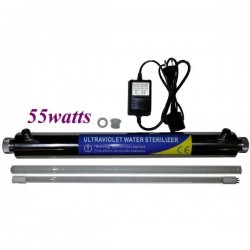No products
Ultraviolet (UV) disinfection uses a UV light source, which is enclosed in a transparent protective sleeve. It is mounted so that water can pass through a flow chamber and UV rays are admitted and absorbed into the stream. When ultraviolet energy, with a 235.7nm wavelength, is absorbed by the reproductive mechanisms of bacteria and viruses, the genetic material (DNA/RNA) is rearranged and they can no longer reproduce, are dead and the risk of disease has been eliminated. The treated water then exits through the top port of the cell and is ready for consumption.
The UVI systems virtually eliminate microbiological contaminants without using potentially hazardous chemicals, without adding or taking anything away from water. The UV disinfection is a cost-effective and environmentally-friendly way to remove 99.99% of harmful waterborne microorganisms.
UV-rays are energy-rich electromagnetic rays that are found in the natural spectrum of the sunlight. They are in the range of the invisible short wave light having a wavelength ranging from 100 to 400 nm (1 nanometre = 10-9m).
Research has confirmed that UV effectiveness is relatively insensitive to temperature and pH differences, and that application of UV as a primary disinfectant (followed by chlorination or chloramination) does not contribute to disinfection by-product formation. In addition, UV application was found not to convert nitrate to nitrite or bromide to bromines or bromates. However, it has long been observed that turbidity, natural organics, iron, calcium hardness, suspended solids, and other factors can reduce UV transmission and cause lamp fouling, thus lowering disinfection effectiveness. Ultraviolet devices are most effective when the water has already been partially treated, and only the cleanest water passes through the UV flow chamber.
The Ultraviolet method of microbiological eradication is commonly used for hospitals, homes, hotels, cottages, schools, waste water treatment, green houses, farms, beauty shops, aquaculture, aquariums, food & beverage industries, laboratories, etc.
Laboratories and factories with low water use but high quality requirements can take advantage of UV disinfection systems to treat their water. Some processes are unable to tolerate chlorine, and the food and beverage industry wants to eliminate the odour and taste of chlorine from their products.
Ultraviolet sterilizers are often used in aquaria and ponds to help control unwanted microorganisms in the water. Continuous sterilization of the water neutralizes single-cell algae and thereby increases water clarity. The UV radiation also ensures that exposed pathogens cannot reproduce, thus decreasing the likelihood of a disease outbreak in an aquarium.
Disinfecting the water with U.V (ultraviolet) light is natural, environmentally safe, cost effective, it's well proven and it's the way of the future for water disinfection requirements around the globe.
Industrial Ultra-Violet Disinfection There are 3 products.
Call For Price
In StockUV SYSTEM 110W
Call For Price
UV System with 2 lamps 55W =110W, 1''inlet- outlet, 5.4t / h max
Call For Price
In StockUV SYSTEM 440W
Call For Price
UV System with 8 lamps 55W =440W, 3'' inlet- outlet, 21.6t / h max
Call For Price
In StockUV SYSTEM 55W
Call For Price
UV System with lamp 55W, 3 /4'' inlet-outlet, 2.7t / h max



